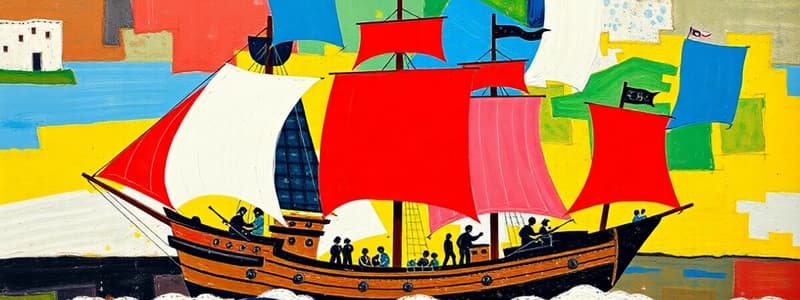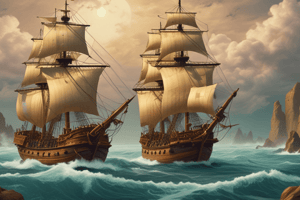Podcast
Questions and Answers
What was one of the primary motivations for European countries during the Age of Exploration?
What was one of the primary motivations for European countries during the Age of Exploration?
- To discover new cultures
- To establish military dominance
- To promote artistic expression
- To seek wealth (correct)
Which ship did Christopher Columbus NOT use during his voyages?
Which ship did Christopher Columbus NOT use during his voyages?
- Santa Maria
- Pinta
- Santa Clara (correct)
- Nina
What mistaken belief did Columbus have about reaching the East?
What mistaken belief did Columbus have about reaching the East?
- He believed the Earth was larger than it actually is.
- He underestimated the distance to Asia by sailing west. (correct)
- He thought he could reach Asia through the Arctic.
- He thought there were no oceanic barriers to reaching Asia.
Who was the first European to reach Brazil?
Who was the first European to reach Brazil?
What lands did Columbus claim for Spain during his voyages?
What lands did Columbus claim for Spain during his voyages?
Who was the first European to reach the Pacific Ocean by land?
Who was the first European to reach the Pacific Ocean by land?
Which explorer is credited with the first circum-navigation of the globe?
Which explorer is credited with the first circum-navigation of the globe?
What significant impact did Hernan Cortes have in the Americas?
What significant impact did Hernan Cortes have in the Americas?
Which explorer claimed lands in Arizona and New Mexico for Spain?
Which explorer claimed lands in Arizona and New Mexico for Spain?
What was the primary motivation for Spain's exploration and conquest of new territories in the Americas?
What was the primary motivation for Spain's exploration and conquest of new territories in the Americas?
Flashcards
The Race for the Americas
The Race for the Americas
The quest for land and wealth in the Americas, especially in the 16th century, led to exploration and conquest by European powers, particularly Spain. It was a race to claim new territories and establish empires, seeking gold and other resources, but with tragic consequences for the native populations.
Who was Vasco Nunez de Balboa?
Who was Vasco Nunez de Balboa?
A Spanish explorer who claimed the Pacific Ocean and surrounding lands for Spain in 1513, marking a significant moment in Spanish expansion across the Americas.
What was Magellan's Achievement?
What was Magellan's Achievement?
Ferdinand Magellan led the first expedition to circumnavigate the globe, starting in 1519. Though he died during the journey, his crew completed the voyage, making history. This achievement solidified Spain's presence in the global exploration scene and established Spain as a formidable power.
Conquest of the Aztecs and Incas
Conquest of the Aztecs and Incas
Signup and view all the flashcards
First North American Settlement
First North American Settlement
Signup and view all the flashcards
What is the Age of Exploration?
What is the Age of Exploration?
Signup and view all the flashcards
What is the significance of Columbus's voyages?
What is the significance of Columbus's voyages?
Signup and view all the flashcards
Who were the key players in the Age of Exploration?
Who were the key players in the Age of Exploration?
Signup and view all the flashcards
Who was the first European to reach Brazil?
Who was the first European to reach Brazil?
Signup and view all the flashcards
Why are the Caribbean islands called 'West Indies'?
Why are the Caribbean islands called 'West Indies'?
Signup and view all the flashcards
Study Notes
The Age of Exploration: Columbus and Beyond
- The voyages of Christopher Columbus marked the start of the Age of Exploration, a race between Spain and Portugal for control of the Americas.
- European countries and monarchs sought wealth, fame, and fortune from exploration, and the spread of Christianity.
- Columbus, an Italian sailing under the Spanish flag, sought a faster trade route to India and China.
- He underestimated the Earth's circumference, leading him to mistakenly believe he reached the East Indies.
- Columbus's voyages led to the discovery of the Americas, claiming lands like Cuba, Antigua, Hispaniola, and the Bahamas for Spain.
- Portugal's Pedro Alvares Cabral reached Brazil in 1500, establishing a vast colony.
- Vasco Núñez de Balboa, a Spaniard, was the first European to see the Pacific Ocean in 1513.
- Ferdinand Magellan's expedition circumnavigated the globe (1519-1522), though he died during the journey.
- Hernán Cortés conquered the Aztec Empire in Mexico for Spain in the 1520s, followed by Francisco Pizarro's conquest of the Incas in the 1530s.
- These conquests were devastating to the native populations.
- Spanish explorations in North America occurred, including Francisco Vásquez de Coronado's expedition to Arizona and New Mexico, and others seeking the mythical Fountain of Youth.
- Pedro Menéndez de Avilés founded St. Augustine, Florida (1565), marking the first permanent European settlement in North America.
- Later, the true value of North America, as a land of fertile ground and moderate climates, was realized.
Reasons for Exploration
- Motivation for exploration included financial gain, personal recognition, and expanding Christian faith.
- A key motive, according to 16th-century explorer Castillo, was to "serve God, to give light to those who were in darkness, and to grow rich as all men desire to do."
Studying That Suits You
Use AI to generate personalized quizzes and flashcards to suit your learning preferences.



